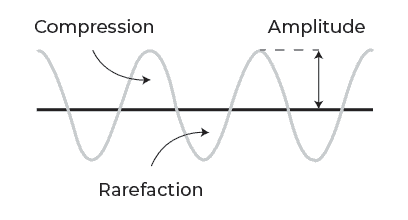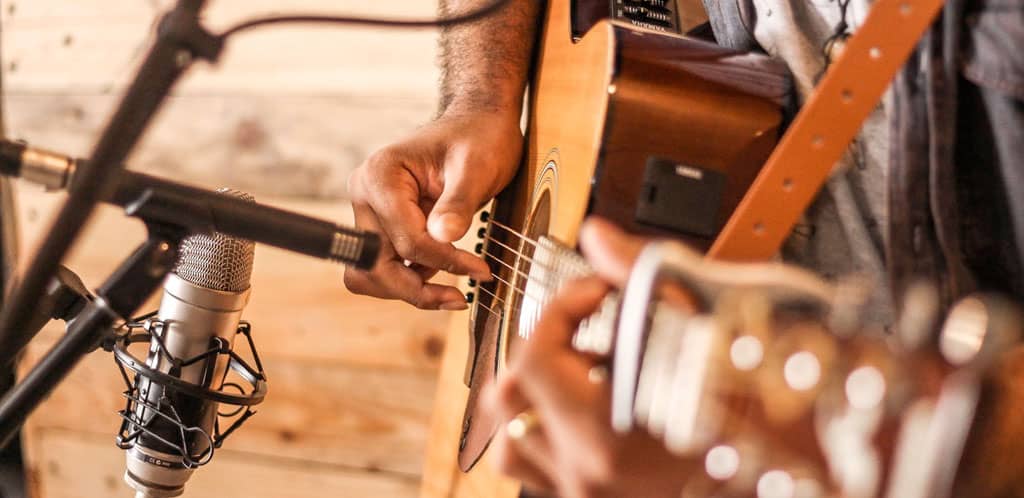Acoustic guitars have soundholes to amplify the sound of the guitar by allowing the acoustic energy inside the body to be released. The vibrations of the soundboard increase air pressure within the body of the guitar. As the air is released via the soundhole the pressure drops forcing more air into the body. This process then repeats.
How sound is created on the acoustic guitar
Forever the source of frustration, the Sarlacc of plectrums, the soundhole plays a huge role in how an acoustic guitar produces sound, or perhaps more accurately, amplifies sound.
What is Sound?
Sound occurs when an object vibrates. Sound waves are made up of high-pressure areas (compression) and low-pressure areas (rarefaction). The height of the sound wave (amplitude) is a measure of the intensity of the sound wave, or volume, and is measured from the center of the sound wave (the point of equilibrium).
The diagram below shows this in more detail.

How does all this relate to the acoustic guitar? The guitar body is essentially an acoustic chamber.
When the guitar is played the vibration from the strings is transferred to the soundboard (the top of the guitar body) via the bridge of the guitar which is attached to the resonant soundboard.
What is resonance?
n Latin resonance means to ‘resound’. In its most basic sense resonance occurs when an object (guitar string) causes a second object (the guitar’s top) to vibrate at the same frequency.
In the case of the acoustic and classical guitar, the bridge is attached directly to the top of the guitar body (soundboard). The soundboard is light and flexible, while the sides of the guitar’s internal walls reflect vibrations from the underside of the soundboard.
The back is stiffer than the soundboard but vibrates in the opposite direction causing the body of the guitar, via the soundhole, to draw air in, and then out of the guitar’s body.
What can, at first appear confusing about this process is that resonance doesn’t introduce additional energy, despite appearing to.
The increase in acoustical energy is due to the transfer of vibrations from a smaller surface to a larger surface e.g. the strings transferring vibrational energy to the larger surface area of the soundboard. As the soundboard is considerably larger more air is then displaced, amplifying the volume of sound generated.
The soundhole contributes to amplification in a couple of ways:
- By removing a section of the soundboard (the soundhole) the weight of the soundboard is reduced increasing its ability to vibrate.
- Secondly, the soundhole allows a point of exit for internal resonance that would otherwise be contained within the guitar body. As we discussed at the beginning of this article, air pressure is increased due to the vibrations of the soundboard compressing the air. As it is released the air pressure is lowered which draws more air into the body of the guitar, and this cycle then repeats. This phenomenon is known as Helmholtz Resonance.
Directional sound waves
Have you ever been listening to a song on your smartphone and noticed its volume appears to increase when you place it into a bowl, despite there being no additional energy introduced?
This occurs because sound waves emanate out from the source of vibration in all directions. Due to the position of the opening of the bowl, the sound waves are focused in one direction as opposed to multiple.
This is also the case for acoustic guitars. The soundhole directs the release of the energy contained within the body of the guitar. You are not hearing an increase in volume, just a more focused/directed sound e.g. volume is louder on the top of the guitar body due to the soundhole but lower toward the back of the guitar due to the absence of a soundhole.
This is one reason why when recording acoustic guitar it’s never a good idea to point the microphone directly at the soundhole. The release of air accentuates bass frequencies, creating a whooshing sound that affects clarity.
Soundhole Size: Why do some guitars have different size soundholes
Most guitars have a round soundhole positioned in the upper third of the body, just above the waist of the guitar. This is the simplest in terms of manufacturing and provides a balanced frequency response. It’s also what guitarists have become accustomed to over the years, but….soundholes don’t need to be circular.
Different types of guitars feature different, and more intricate soundhole designs, the Godin Multiac is one such example, along with the Ovation Guitars Applause, which features multiple, strategically placed smaller holes.
Another variation on the soundhole is the classic F hole, seen mostly on violins and other stringed instruments such as semi-hollow archtop guitars.
Modern Gibson acoustics feature ‘player port (aka sound port)‘ soundholes on the side of the guitar’s body, in addition to the soundhole located on the soundboard. While numerous other manufacturers utilize offset soundholes, which as the name implies means the soundhole is not centered on the guitar body.
While there’s an obvious aesthetic appeal to the different soundhole designs seen on the guitars listed above, it’s also true that altering the location and shape of the sound hole/s can influence the tone, volume, and projection of the guitar.
It’s generally accepted that the smaller the soundhole area the less volume produced.
In the case of semi-acoustic guitars like the Godin Multiac, as the guitar is designed to be played through an amplifier, the lack of volume compared to a standard acoustic guitar design is perhaps less of a consideration.
But this is correct only right up to a point.
While the soundhole influences volume, the shape of the guitar along with the acoustic properties of the tonewoods the guitar is constructed from also contribute, making it a far more holistic affair.
Summary
As we can see, the soundhole of your guitar does a lot more than just swallow guitar picks. The main reason acoustic guitars have sound holes is to amplify the transferred energy of the strings and resonance in the body of the guitar. They also contribute to feedback when the guitar is amplified but that’s another story for another day.


